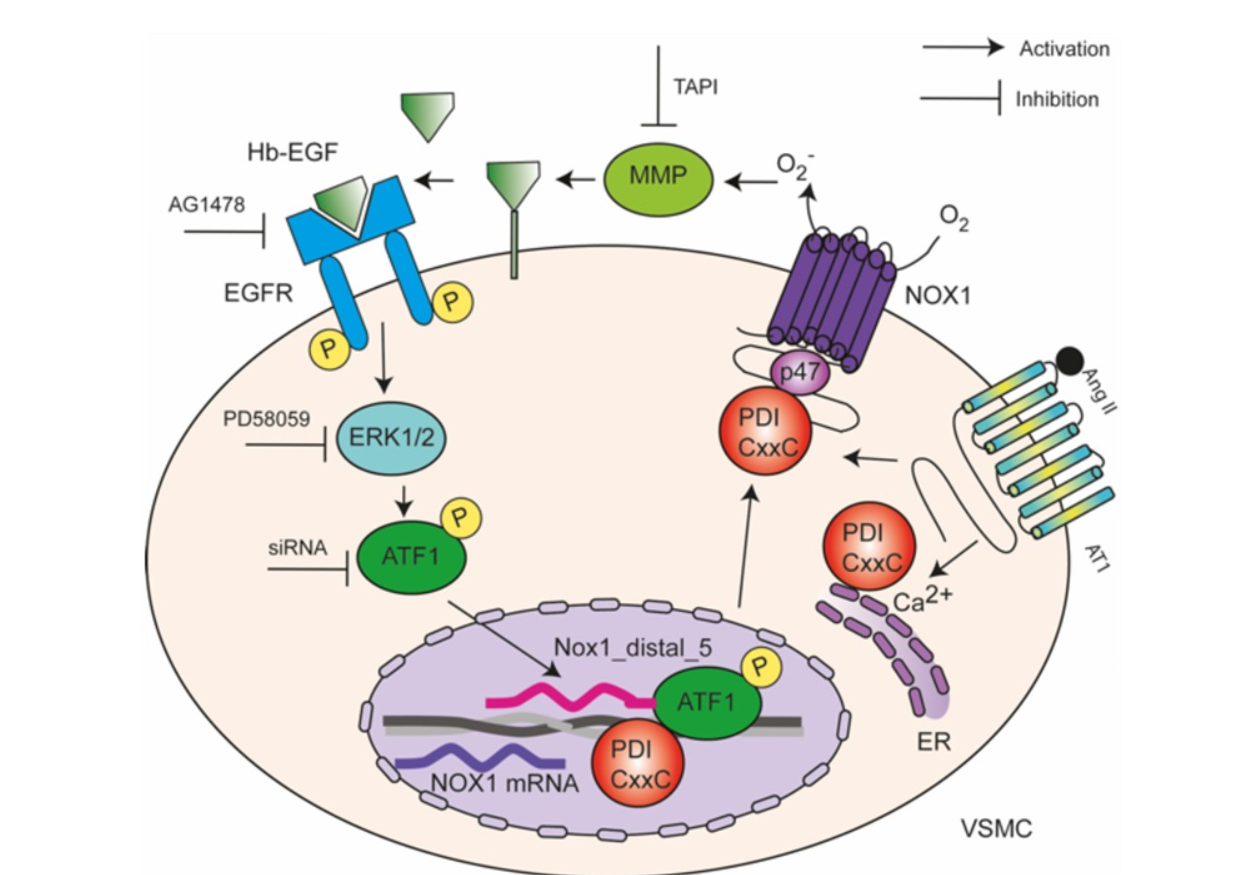

The researchers found that PDIA1 plays an important role in the pathogenesis of hypertension through the regulation of Nox1 gene expression induced by the transcription factor ATF1 and calcium mobilization, which increases vascular tone and contributes to elevated blood pressure (Graphical Abstract — Camargo et al., Journal of Hypertension 42(6):984-999, June 2024 — Copyright © 2024 Wolters Kluwer. Published by Lippincott Williams & Wilkins)
Discovery at the Center for Redox Processes in Biomedicine showed positive results in hypertensive rats and therapeutic potential.
Discovery at the Center for Redox Processes in Biomedicine showed positive results in hypertensive rats and therapeutic potential.

The researchers found that PDIA1 plays an important role in the pathogenesis of hypertension through the regulation of Nox1 gene expression induced by the transcription factor ATF1 and calcium mobilization, which increases vascular tone and contributes to elevated blood pressure (Graphical Abstract — Camargo et al., Journal of Hypertension 42(6):984-999, June 2024 — Copyright © 2024 Wolters Kluwer. Published by Lippincott Williams & Wilkins)
Agência FAPESP* – Research conducted by the Center for Redox Processes in Biomedicine (Redoxoma), a Research, Innovation and Dissemination Center (RIDC) funded by FAPESP and based at the Institute of Chemistry of the University of São Paulo (IQ-USP), has shown that the protein disulfide isomerase A1 (PDIA1) plays an important role in hypertension.
Hypertension is associated with dysfunction of the endothelium, the thin layer of epithelial tissue that lines the inner wall of all blood vessels. The dysfunction is characterized by an imbalance in the release of contractile and relaxing factors in the tissue, with an increase in the production of reactive oxygen species to the detriment of nitric oxide. The main source of the superoxide free radicals in vascular cells is the enzyme NADPH oxidase 1 (Nox1), whose activation can be regulated by various factors, including protein A1 (PDIA1).
The researchers found that PDIA1, or simply PDI, plays an important role in the pathogenesis of hypertension by regulating the expression of the Nox1 gene, which is induced by the transcription factor ATF1, and the mobilization of calcium, which increases vascular tone and contributes to the increase in blood pressure. The authors previously identified PDI as a novel protein that regulates Nox1 signaling in vascular smooth muscle cells.
Transcription factors are proteins that bind to specific DNA sequences, called enhancers, and help regulate gene transcription. Transcription is the process by which genetic information is copied from DNA to RNA.
“We’ve now shown how PDI regulation happens at the transcriptional level: it acts on the Nox1 gene, regulating the enzyme’s gene expression. The beauty of this work is that we investigated the signaling in the cells and then tested the functional effect in the vessel, in arteries of spontaneously hypertensive rats,” says Lucia Rossetti Lopes, professor at USP’s Biomedical Sciences Institute (ICB) and principal investigator of the Redoxoma study.
PDIA1 is the prototype of the PDI family, which belongs to the thioredoxin superfamily. It is an essential protein for the survival of human cells with important physiological functions. PDI is involved in signaling and redox homeostasis. Its classical function is to catalyze the insertion of disulfide bridges into nascent proteins in the endoplasmic reticulum, ensuring their correct folding.
The relationship between PDI and oxidant production involves NADPH oxidase (Nox), a family of enzymes that catalyzes the reduction of molecular oxygen to produce the superoxide radical anion, which in turn participates in the production of other oxidants. In the human vasculature, different members of the Nox family control physiological functions such as growth, migration and modification of the extracellular matrix in vascular smooth muscle cells.
The details of the work were published in the article “Protein disulfide isomerase-mediated transcriptional upregulation of Nox1 contributes to vascular dysfunction in hypertension” in the Journal of Hypertension.
Results and therapeutic target
Comparing vascular smooth muscle cells (VSMCs) from spontaneously hypertensive rats with cells from control Wistar rats, the researchers found that PDI increases Nox1 transcription by activating the epidermal growth factor receptor, which is responsible for cell signaling, proliferation, migration and contraction.
PDI also promotes the translocation of the transcription factor ATF1 to the nucleus of cells. By studying the region of the Nox1 gene with which ATF1 associates, they discovered that it binds to enhancers.
They also showed for the first time that the sulfenylation of PDI by hydrogen peroxide contributes to epidermal growth factor receptor activation in hypertension. The sulfenylation of PDI was greater in cells from spontaneously hypertensive rats than in control animals, suggesting greater oxidation of PDI in hypertension.
In the article, the researchers show the clear correlation between increased expression of Nox1, PDI and blood pressure. “That’s why I think it has some therapeutic potential. Currently, the main drugs we use to treat hypertension are angiotensin-converting enzyme [ACE] inhibitors, which inhibit the formation of angiotensin II, one of the main activators of Nox1. ACE inhibitors suggest that the mechanism we’ve uncovered may actually be a therapeutic target,” Lopes points out.
The big question, according to the researcher, would be to discover a new class of drugs with greater specificity and, therefore, fewer side effects. “We’d need to look for inhibitors that could inhibit the angiotensin II pathway downstream of the AT1 receptor, which would be more specific. PDI could offer a way to do that,” he points out.
* With information from Redoxoma.
Republish
The Agency FAPESP licenses news via Creative Commons (CC-BY-NC-ND) so that they can be republished free of charge and in a simple way by other digital or printed vehicles. Agência FAPESP must be credited as the source of the content being republished and the name of the reporter (if any) must be attributed. Using the HMTL button below allows compliance with these rules, detailed in Digital Republishing Policy FAPESP.





